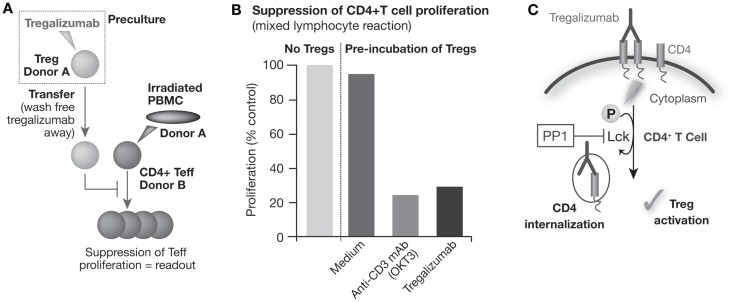Figure 1.
Tregalizumab is able to activate the suppressive capacity of regulatory T cells. (A) Tregs were isolated and pre-incubated with plate-bound tregalizumab, OKT-3 mAb, or medium and transferred to a mixed lymphocyte reaction using allogeneic, CD3-depleted, irradiated PBMCs to activate the proliferation of Teffs. (B) The proliferation of allogenic stimulated Teffs with tregalizumab pretreated Tregs is shown compared with the proliferation without Tregs. (C) Tregalizumab engages the TCR signaling pathway. Incubation of Tregs with tregalizumab evokes signaling events in Tregs that mimic a signal through the T cell receptor complex without the need for direct CD3 or TCR stimulation. T cell receptor complex signaling represents a crucial event in the activation of Tregs since blockade of the corresponding signaling pathway resulted in the loss of suppressive activity of Tregs. Tregalizumab delivers a comparable signal as usually conferred by TCR binding in Tregs, resulting in activation/phosphorylation of the T cell receptor downstream signaling molecule ZAP-70 (ζ-chain-associated protein). This event leads to signals that finally trigger internalization of the tregalizumab–CD4 complex. As a consequence, CD4 expression levels on CD4+ T cells are downmodulated by tregalizumab in the physiological setting. This downmodulation causes a transient decrease of CD4 molecules on the cell surface, which is followed by a recovery of expression levels over time (67, 69).

